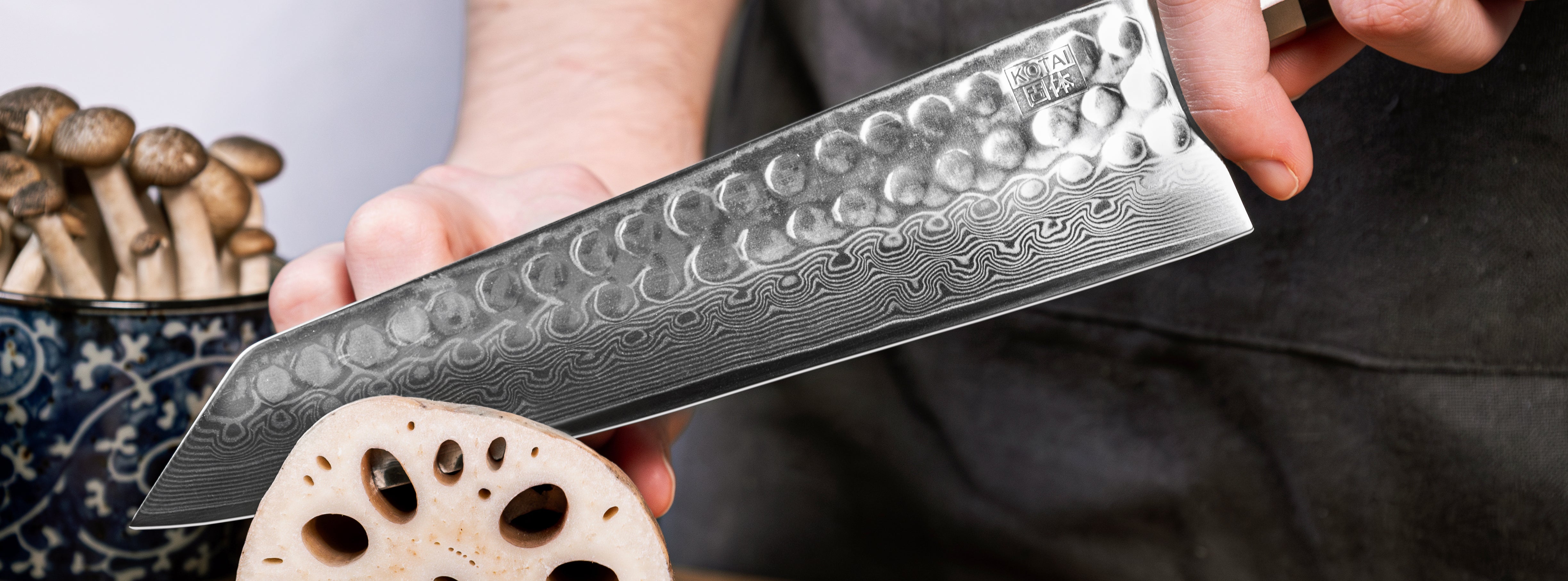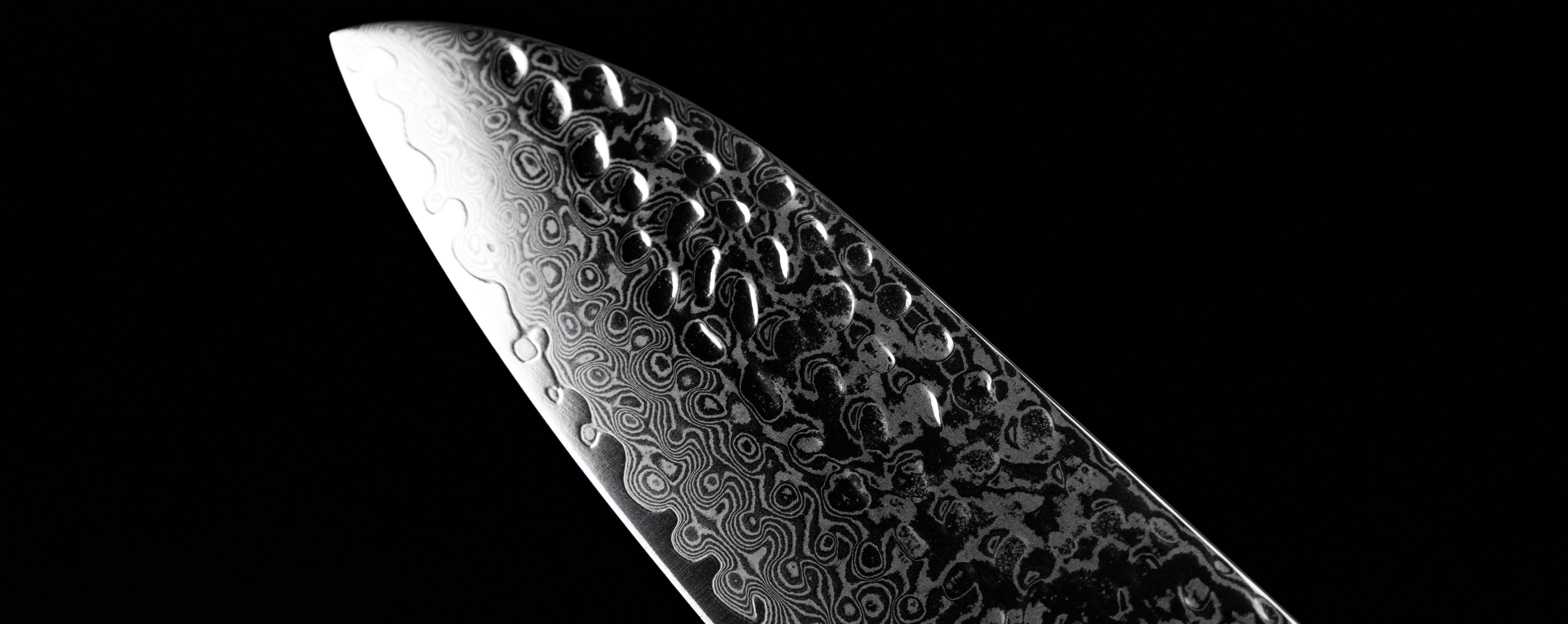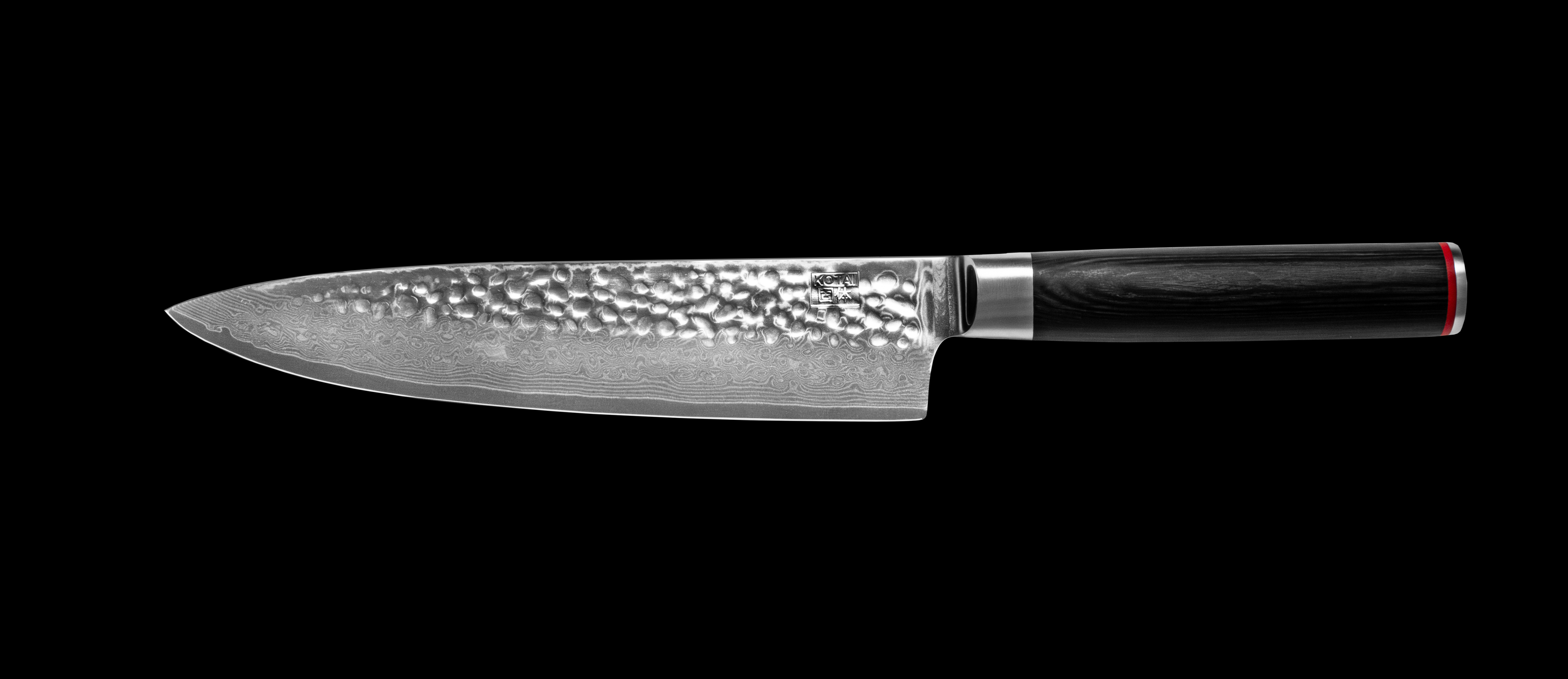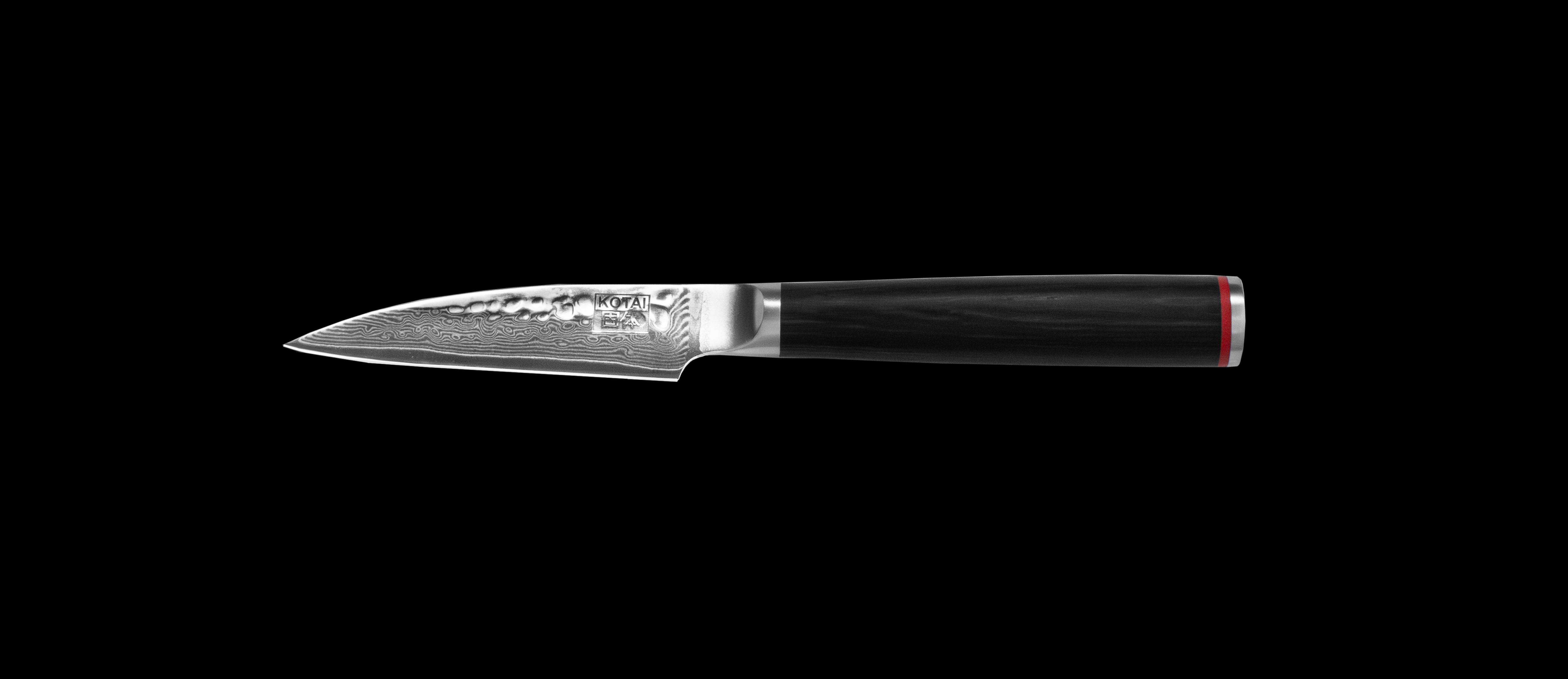But what is a Damascus kitchen knife?
This is a question that you have probably already asked yourself, given the growing trend around Damascus kitchen knives. The term "Damascus" refers to a particular type of steel that has become very popular, mainly because of its aesthetic appeal. Thanks to the particularity of damascus steel, each knife has its own unique design!
In this article, we will provide you with the essential information you need to know about Damascus steel:
- The origin and significance of Damascus steel
- The specific characteristics of Damascus steel
- Damascus steel knives by KOTAI
I - Origin of Damascus steel
Damascus steel - also known as Damast steel (DE) - is thought to be a descendant of the Wootz steel used in India and the Middle East in the 300s BC. The technique used to forge Damascus blades is thought to have been perfected in Damascus, capital of Syria, for the manufacture of swords and sabres.
However, the exact origin and significance of Damascus steel is subject to controversy, and many theories exist on the matter. The difficulty lies in the complexity of accurately tracing its history, given its rapid evolution through different regions of the world over the centuries. Moreover, the loss of Damascus steel's original manufacturing process in the 18th century has contributed to further obscuring theories about its origin.
For the vast majority, the origin of the name "Damascus Steel" seems to be directly linked to the capital of Syria, offering a simple and direct explanation. However, according to other theories, the steel may have originally been made in Iran, and the name "Damascus" may simply derive from a precious fabric woven in Damascus that featured patterns similar to those on forged damascus steel blades.
But one thing is certain: over the centuries, Damascus steel has become a symbol of quality, elegance and exception.
II - Features of Damascus steel
The distinctive feature of Damascus steel comes mainly from its manufacturing process: several layers of steel are hammered, folded and forged together. Heat treatment of the blade then brings out the contrast between the different layers, creating a unique pattern, unique to each knife! This meticulous process gives the blades more than just their visual beauty - it also gives them exceptional functional characteristics.
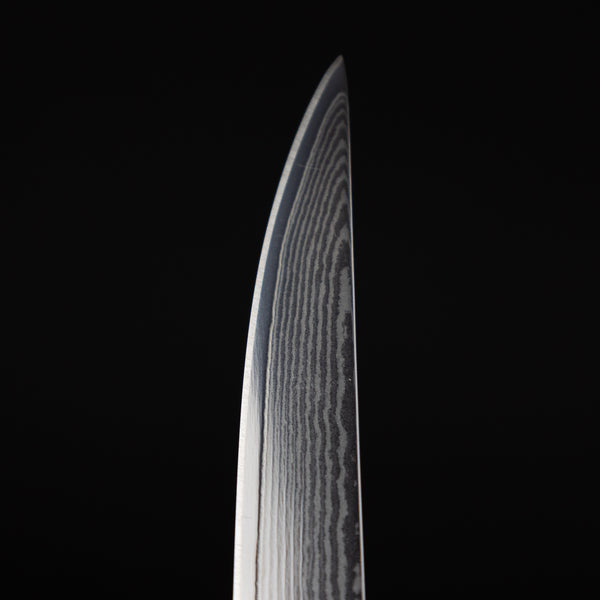
ADVANTAGES
- Increased durability: Damascus steel combines multiple layers of steel to create a more robust structure that is highly resistant to everyday use.
- Exceptional sharpness: The high carbon content of damascus steel gives blades a powerful cutting edge that lasts over time.
- High resistance to corrosion: The combination of carbon steel and stainless steel offers greater
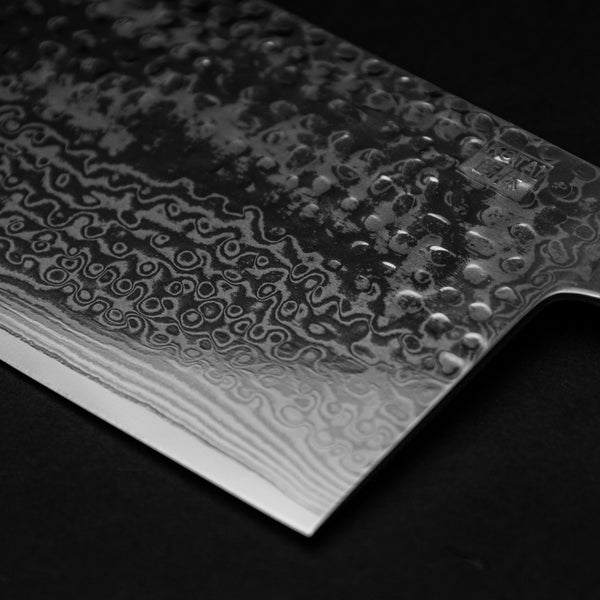
DISADVANTAGES
- High cost: Due to the complexity of the steel manufacturing process, Damascus steel kitchen knives can be more expensive. However, its high quality and unique aesthetic justify the investment.
- Rigorous maintenance: Although resistant to corrosion, Damascus steel knives require regular maintenance to maintain their shine and sharpness.
Having trouble keeping your knives sharp? Take a look at our maintenance tips!
III - KOTAI and Damascus steel
KOTAI is the perfect fusion of two very different worlds: the art of Japanese and German cutlery. Our hybrid kitchen knives are specially designed so that you can benefit from the strengths of these two distinct areas of expertise, without the drawbacks.
A KOTAI kitchen knife is a sharp blade with a precise Japanese edge, combined with German sturdiness and high resistance to oxidation!
Unlike our previous PAKKA and BUNKA collections, forged from a single layer of high-carbon 440C stainless steel, our new Damascus steel ranges are made up of a central layer and a succession of 33 layers of steel superposed on each side. These 67 layers of steel give our blades exceptional cutting performance as well as superior durability and strength!
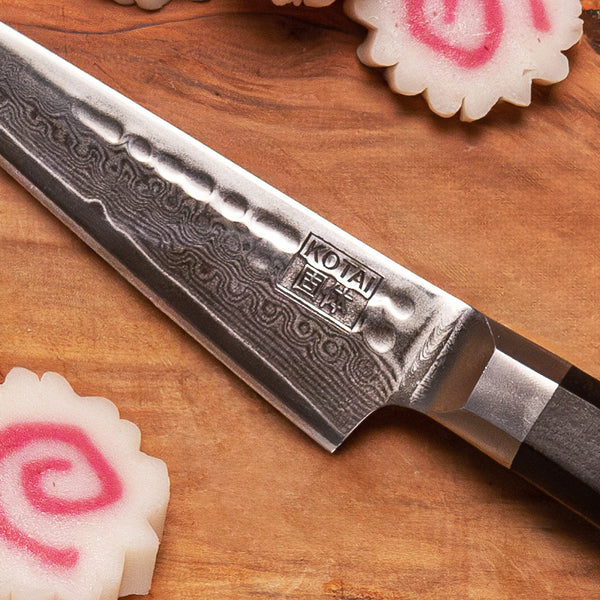
- In addition to its wave-like aesthetic qualities, which make each of our knives unique, damascus steel combines the advantages of a very high-carbon steel - the AUS-10 layer at the heart of the blade reaches an HRC hardness of 61 - with the benefits of 'softer' steels, such as resistance to impact and corrosion.
Note: The hardness of a steel contributes to a blade's resistance to use and impact. It is measured in HRC, the Rockwell hardness scale. The harder the steel, the more durable the edge of the blade. The average hardness of a professional kitchen knife is between 56-58 HRC!
As previously mentioned, keeping your damascus steel kitchen knives sharp requires regular maintenance, either by sharpening them with a honing steel, or by sharpening them with one of our two whetstones, available in 180/800 or 2000/6000 grit.
If you're having difficulty distinguishing between sharpening and honing, do not hesitate to consult our simple help guide!
IV - Damascus kitchen knives - KOTAI
The Gyuto; or the chef's knife
Our Damascus Gyuto PAKKA Collection chef's knife is forged from AUS-10 steel, which combines a high carbon content with an optimal amount of chromium. The characteristics of the damascus steel optimize the durability of the blade's cutting edge thanks to a hardness of HRC 61, while preventing oxidation.
In addition, its 20-centimeter blade is the ideal size for the perfect balance between handle and blade. Finally, the hammering (present on all our knives) on the blade prevents food from sticking to the knife when cutting.
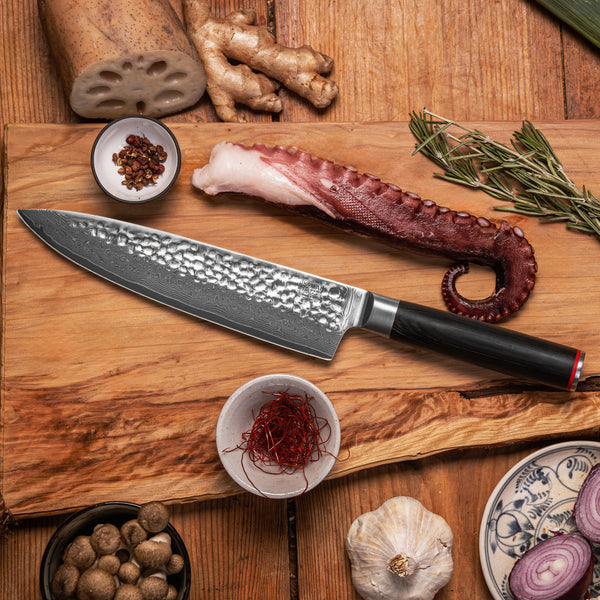
The Damascus Gyuto PAKKA Collection
Details of our Damascus Gyuto PAKKA Collection:
- Handcrafted from ultra-sharp, high-carbon AUS-10 Japanese stainless steel
- Double bevel, suitable for right or left-hand cutting
- The partial bolster allows the blade to be sharpened along its entire length
- The knife's full hidden tang gives it ideal balance and durability
- Blade length: 20 cm
- Back thickness: 1.8 mm
- Knife weight: 207 g
- HRC hardness: 61 +/-
- Handle material: Pakkawood
The Santoku; or the versatile knife
Our Damascus Santoku BUNKA Collection is a variant of the classic Japanese Santoku knife, but slightly smaller with a 17-centimeter blade.
It is easily recognisable thanks to its "Inverted Tanto" - or "K-tip" - blade profile, which is shaped differently from the common Santoku. This particular profile gives it greater precision when cutting, as well as a long-lasting razor-sharp edge provided by the components of AUS-10 steel.
Finally, its handle also differs from a conventional Santoku thanks to its octagonal shape made from ebony - a magnificent dark natural wood - famous for its strength and ability to age well.
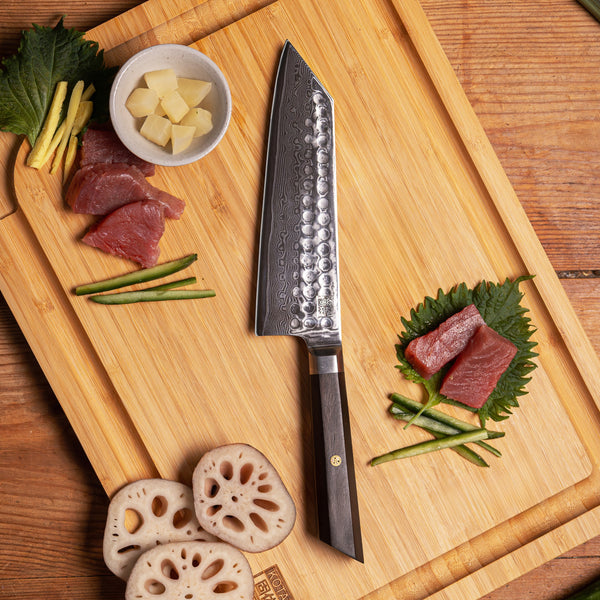
The Damascus Santoku BUNKA Collection
Details of our Damascus Santoku BUNKA Collection:
- Handcrafted from ultra-sharp, high-carbon AUS-10 Japanese stainless steel
- Double bevel, suitable for right or left-hand cutting
- The partial bolster allows the blade to be sharpened along its entire length
- The knife's full hidden tang gives it ideal balance and durability
- Blade length: 17 cm
- Back thickness: 1.8 mm
- Knife weight: 190 g
- HRC hardness: 61 +/-
- Handle material: Ebony wood
The paring knife ; or peeling knife
Our Damascus Paring Knife PAKKA Collection is the perfect hybrid between the shape of a sheep's foot and a spear point - find out more about the different shapes of paring knife here! The edge of the blade is largely flat, for precision and easy peeling, while the tip is slightly pointed for more complex tasks.
Finally, its round, hand-polished, water-resistant black Pakkawood handle ensures a firm, comfortable grip even with wet hands.
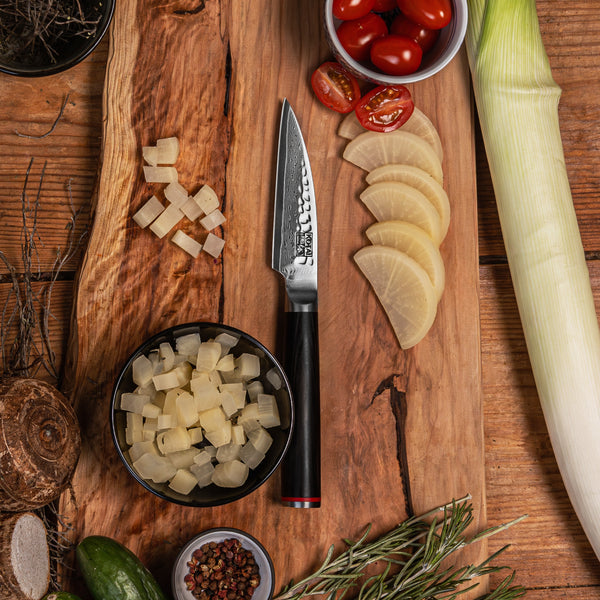
The Damascus Paring Knife PAKKA Collection
Details of our Damascus Paring Knife PAKKA Collection:
- Handcrafted from ultra-sharp, high-carbon AUS-10 Japanese stainless steel
- Double bevel, suitable for right or left-hand cutting
- The partial bolster allows the blade to be sharpened along its entire length
- The knife's full hidden tang gives it ideal balance and durability
- Blade length: 9 cm
- Back thickness: 1.5 mm
- Knife weight: 90 g
- HRC hardness: 61 +/-
- Handle material: Pakkawood
To sum up…
To conclude, Damascus steel is an exceptional material that gives a kitchen knife a razor-sharp edge combined with good corrosion resistance, as well as increased durability due to the assembly of several layers of steel.
For KOTAI, using this very special material to make its hybrid kitchen knives was an obvious choice. AUS-10 steel combines the characteristics of both worlds in a KOTAI knife: precision cutting and strength. Moreover, the aesthetics brought by the forging of Damascus blades sublimates our knives, and makes them all unique.
So do not wait any longer and snap up one of our best-sellers:
- Our chef's knife; Damascus Gyuto PAKKA Collection
- Our Damascus Santoku BUNKA Collection
- Our Damascus Paring Knife PAKKA Collection
Need expert advice? Find out how to choose your first kitchen knife, or discover the 4 essential kitchen knives!
 English
English French
French

